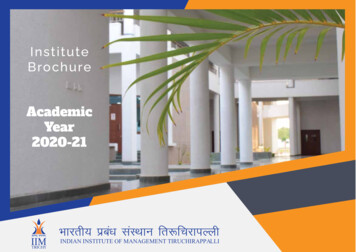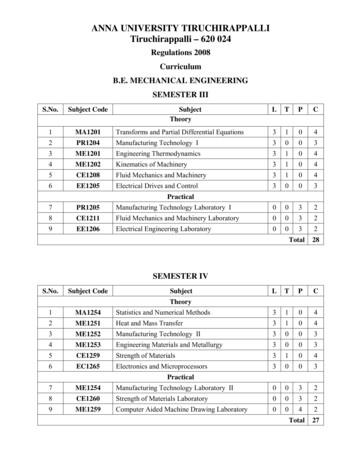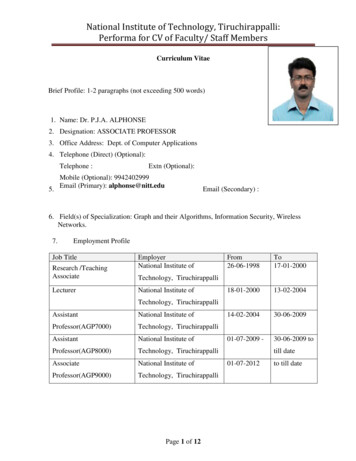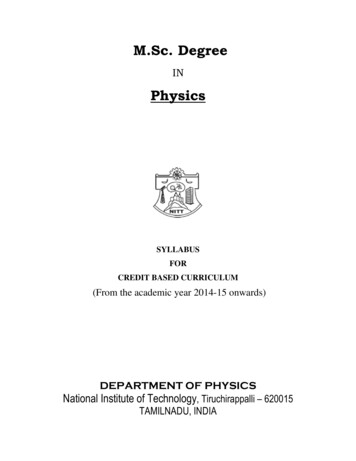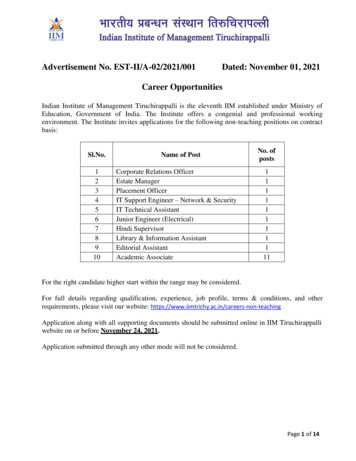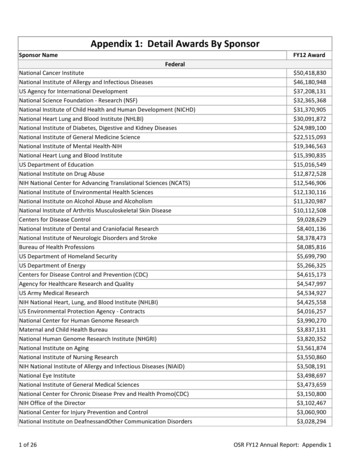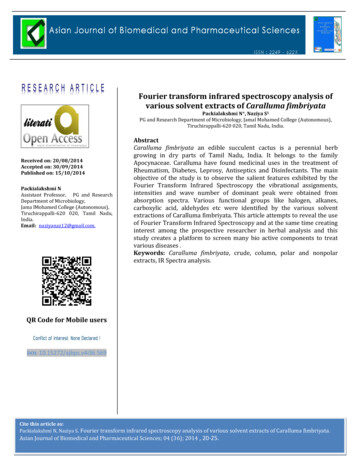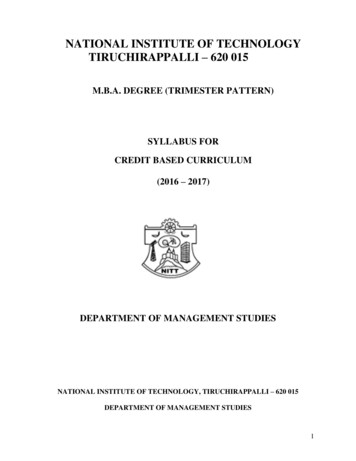
Transcription
NATIONAL INSTITUTE OF TECHNOLOGYTIRUCHIRAPPALLI – 620 015M.B.A. DEGREE (TRIMESTER PATTERN)SYLLABUS FORCREDIT BASED CURRICULUM(2016 – 2017)DEPARTMENT OF MANAGEMENT STUDIESNATIONAL INSTITUTE OF TECHNOLOGY, TIRUCHIRAPPALLI – 620 015DEPARTMENT OF MANAGEMENT STUDIES1
MASTER OF BUSINESS ADMINISTRATION (CREDIT SYSTEM)Objective of the Programme:The programme provides development of comprehensive knowledge and skills to managebusinesses in the emerging environment. It is structured to enable undergraduate students of anydiscipline to evolve as Masters in Business Administration. The programme focuses on generalmanagement concepts along with orientation towards functional areas such as Marketing,Finance, Human Resources and Technology & Operations. In addition to these verticalspecializations, the programme offers horizontal specializations in “Business Analysis & ITConsulting” and “Business Analytics” with focus on IT services and Analytics industryrespectively.2
MBA PROGRAMME 2016-17Total minimum credits required for completing the course is 80(2 Credits are allocated for every three hours of Lecture as the entire course is delivered in 30 hours)TRIMESTER – ICODECOURSE OF ss StatisticsLegal Aspects of BusinessFundamentals of Financial AccountingMarketing Management – Concepts and DesignMicro EconomicsOrganizational Structures & DesignBusiness Communication - ITotal2323331610100002000000222222222142TRIMESTER – IICODECOURSE OF STUDYLTPCMB 711MB 712MB 713MB 714MB 715MB 716MB 717MB 718Advanced Financial AccountingCost and Management AccountingOperations ResearchMacro EconomicsManaging People in OrganizationsMarketing Management – Planning & controlInformation ManagementBusiness Communication- STER – IIICODECOURSE OF STUDYLTPCMB 721MB 722MB 723MB 724MB 725MB 726Financial ManagementProduction & Operations ManagementHuman Resource ManagementInformation Strategy & ManagementMarketing ResearchBusiness Communication- 00200222222122153
TRIMESTER – IVCODECOURSE OF STUDYLTPCMB 731MB 732MB 733Strategic ManagementSupply Chain ManagementSummer Project*Elective – 3Elective – 4Elective – 5Elective – 6Elective –7Total33300000022230023330000002223000021618* Students take up summer projects during May-July and is evaluated along with IV Trimester courses.TRIMESTER – VCODECOURSE OF STUDYLTPCMB 741MB 742Project System ManagementStrategic Total Quality ManagementElective – 8Elective – 9Elective – 10Elective – 11Total333333180000000000002222220012COURSE OF STUDYLTPCElective – 12Elective – 13Elective – 14Elective – 15333300000000222212008TRIMESTER – VICODETotal4
SPECIALIZATIONSFINANCIAL MANAGEMENTCODECOURSE OF STUDYLTPCMB 761MB 762MB 763MB 764MB 765MB 766MB 76733333330000000000000022222223002MB 769MB 770MB 771Asset Based FinancingAdvanced Corporate FinanceFinancial DerivativesFinancial Institution & ServicesInsurance & Pension SchemesInvestment BankingInvestment Security Analysis and PortfolioManagementStrategic cost Accounting &Management controlTax Laws and Tax PlanningTreasury ManagementPersonal FinanceMB772MB773MB774Behavioural FinanceInternational FinanceCorporate 000P200000000C222222222MB 768HUMAN RESOURCES MANAGEMENTCODEMB 781MB 782MB 783MB 784MB 785MB 786MB 787MB 788MB 789COURSE OF STUDYPersonal Growth programmeChange managementCompensation & BenefitsCounseling in the workplaceStrategic Human Resource DevelopmentTraining and DevelopmentTalent ManagementIndustrial Relations & Labour LawsInternational Human resource ManagementBUSINESS ANALYSIS & IT CONSULTINGCODEMB 801MB 802MB 803MB 804MB 805MB 806MB 807COURSE OF STUDYIntroduction to Business Analysis &IT consultingBusiness Analysis & ITC in Banking&Financial ServicesBusiness Analysis & ITC in Marketing andRetailBusiness Analysis & ITC in ManufacturingSystems Analysis & Design and CASESoftware Project ManagementSoftware Quality ManagementL3T0P0C23002202233330000000022225
BUSINESS ANALYTICSCODEMB 821MB 822MB 823MB 824MB 825MB 826MB 827MB 828MB829MB830MB 831MB 832MB 833MB 834MB 835COURSE OF STUDYBasic Data AnalyticsAdvanced Data AnalyticsData Mining TechniquesIntroduction to Business AnalyticsSupply Chain AnalyticsFinancial Risk AnalyticsHR AnalyticsDigital AnalyticsAnalytics for Strategic marketplanningAnalytics for Strategic marketImplementationBig Data Analytics & Data ScienceAdvanced Data MiningData Analytics Software LabGame Theory & ApplicationsMachine Learning ING MANAGEMENTCODEMB 841MB 842MB 843MB 844MB 845MB 846MB 847MB 848MB 849MB 850MB 851MB 852MB 853MB 854MB 855COURSE OF STUDYMarketing MetricsConsumer BehaviourCustomer Relationship ManagementDirect MarketingBusiness Market ManagementInternational MarketingRural MarketingServices MarketingAdvertising ManagementDistribution ManagementRetail ManagementSales ManagementStrategic Brand ManagementStrategic MarketingDigital MarketingTECHNOLOGY & OPERATIONS MANAGEMENTCODEMB 871MB 872MB 873COURSE OF STUDYAdvanced Materials ManagementAdvanced Operation ResearchInnovation and R&D ManagementL3336
MB 874MB 875MB 876Logistics ManagementProduction Planning & ControlTechnology Forecasting333000000222MB877MB878Manufacturing StrategyServices Operation Management000022MB 879Technology NERAL MANAGEMENTCODEMB 890MB 891COURSE OF STUDYCourse of Independent StudyIntellectual Property rights ManagementMB 892Entrepreneurship & Small BusinessManagementInformation and Internet EconomicsKnowledge Management & InnovationInternational Business & StrategyDesign Thinking & InnovationMB 893MB 894MB 895MB 8967
MB 701 BUSINESS STATISTICSOBJECTIVETo create an understanding on different statistical techniques for data analysis and decisionmakingUnit I Measures of Central Tendency & DispersionIntroduction to statistics-Collecting & tabulating data - Measure of Central Tendency andDispersion in Frequency Distribution- Probability Theory: classical, objective & subjectiveApproach-Addition, Multiplication & Bayes Theorem –ApplicationsUnit II Probability DistributionsBinomial, Poisson and Normal - Decision Making under certainty, uncertainty and RiskUnit III Sampling Distribution & EstimationSampling and Sampling Distribution: Types of sampling —Random Sampling-Concept ofStandard Error Central Limit Theorem. Estimation: Types of estimates-Point Estimate, Intervalestimate of their population mean, variance and proportion-student-t distribution.Unit IV Hypotheses TestingTesting Hypotheses Significance level-Type & Type II error- one Two tail tests —HypothesisTesting of means, proportion-Chi-Square Test-Analysis of variance.Unit V Non Parametric methodsNon Parametric methods Kolmogorov Test-Median Test – Mann –Whitney Test – Wircoxon TTest – Friedman ANOVA-Mcnemar Test-Cochram’s Q Test.TEXT / REFERENCES:1.Richard I. Levin and David S. Rubin, ‘Statistics for Management’, Prentice Hall of India,12h edition’ 20112.Srivatasava, Shenoy and Sharma, ‘Quantitative Techniques for Managerial DecisionMaking’,3.New Age International Pvt. Ltd.,2nd edition, 2002.4.G C Beri, “ Business Statistics”, Tata Mc Graw Hill, 3rd edition, 2009.MB 702 LEGAL ASPECTS OF BUSINESS8
OBJECTIVES:To Provide Students with Basic Legal Concepts and the Indian Legal Environment inwhich Business operates and to expose the Students to the Concepts ofContract Act- - Sale of Goods -Company Law- Consumer Protection Act and InformationTechnology Act.Unit I Indian Contract Act 1872Essential of a valid contract- Void Agreements- Definition of contract- Formation of a contractperformance of contracts- breach of contract and its remedies- Quasi contracts- Contracts ofIndemnity - Meaning- nature - Right of Indemnity Holder and Indemnifier-Contracts ofGuarantee - Meaning- Nature and Features - Types of Guarantee-- Provisions relating to varioustypes of Guarantee- Surety and Co-surety - Rights and Liabilities - Discharge of surety from hisliabilityUnit II Sale of Goods Act 1930Sales contract- Transfer of title and risk of loss- Guarantees and Warranties in sales contractperformance of sales contracts- conditional sales and rights of an unpaid seller. Nature of agency– Creation of agency- types of agents- Agent’s authority and liability of principal and third partyRights and duties of principal- agents and Third party- liability of agents- termination of agency.Unit III Company LawMajor principles – Nature and types of companies- Formation- Memorandum and Articles ofAssociation- Prospectus- Power- duties and liabilities of Directors- winding up of companiesCompany management – Company meetings (Board and General) – Majority rule and Minorityprotection – Compromises- Arrangements-Reconstruction and Amalgamation – Winding Up.Unit IV Consumer Protection Act and FEMADefinitions of Consumer- Complainant- Goods- Service - Meaning of Consumer DisputeComplaint - Unfair Trade Practices - Restrictive Trade Practices- Rights of ConsumersConsumer Disputes Redressal Agencies-Right to Information Act. Introduction to FEMARegulation over transactions in foreign exchange and security- Restrictions on current accountand capital account transactions- Control over realization of foreign exchangeUnit V Information Technology ActThe Information Technology Act-2000 and 2002-Digital Signature - Digital SignatureCertificate- Electronic Governance- Electronic Records- Certifying Authorities- Penalty &Adjudication - Introduction to Cyber Laws -Cyber crimes.TEXT BOOKS:1. N. D. Kapoor- Elements of mercantile Law- Sultan Chand and Company- India- 2006.2. P. K. Goel- Business Law for Managers- Bizentra Publishers- India- 20083.Majumdar- A.K. and Kapoor- G.K.- ‘Company Law and Practice’- Taxman Publications- NewDelhi- Revised 2000.9
REFERENCES:1. P. P. S. Gogna- Mercantile Law- S. Chand & Co. Ltd.- India- Fourth Edition- 2008.2. Akhileshwar Pathack- Legal Aspects of Business- 4th Edition- Tata McGraw Hill- 20073. V. S. Datey- Taxman Publication- 21st Edition- 20084. Daniel Albuquerque,” Legal aspects of Business”, Oxford university press,2013MB 703 FUNDAMENTALS OF FINANCIAL ACCOUNTINGOBJECTIVES:This course is an introduction to financial accounting and provides a basic knowledge bypresenting the mechanism of double entry book keeping which is then extended on the one handfor internal accounting purpose to managerial accounting and on the other hand for externalpurposes to balancing according to the prevailing regulations. Besides the basic theories, manyexamples and cases grant the students some practical experiences. The content is completed byshowing some important international developments in accounting. The course starts bydetermining the role of book keeping in corporate accounting system and explains the techniquesof book keeping.OUTCOMES:After completing this Course the students will be Conversant with: Accounting Concepts Accounting Equation Rules of Accounting Recording the transactions Adjusting & Rectifying the books Preparation of Financial StatementsUnit I Introduction to AccountingMeaning, Functions and Sub fields of Accounting - Accounting Cycle - Accounting PrinciplesConcepts & Conventions - Accounting Equation - Types of Accounts - Rules of Debit & CreditUnit II Accounting ProcessAnalyzing transactions - Recording transactions - Posting to ledger - Balancing the accounts Preparing Trial BalanceUnit III Finalization of AccountsRectifying the erroneous entries - Journalizing adjustment entries - Preparing Adjusted TrialBalance - Passing the closing or transfer entries - Preparing financial statementsUnit IV Inventory AccountingThe basics of inventory - Inventory accounting systems - Inventory valuation methods Accounting for inventory - Inventory and its impact on financial statements.Unit V Depreciation Accounting10
The basic concepts of depreciation - The methods of depreciation - Accounting for depreciation- Depreciation and its impact on cash flow and income taxTEXTBOOKS:Maheshwari S N and Maheshwari S K, “ An Introduction to Accountancy”, Vikas PublishingHouse, 9th Edition, 2007Gupta, Ambrish, “Financial Accounting for Management. An Analytical Perspective”,PearsonEducation, 2nd Edition, 2008.REFERENCES:Ramachandran N and Kakani, Ram Kumar, “Financial Accounting for Management”, TataMcGraw Hill, 2nd Edition, 2008Narayanaswamy R, “Financial Accounting – A Managerial Perspective”, Prentice Hall of India.2nd Edition, 2008MB 704 MARKETING MANAGEMENT - CONCEPTS AND DESIGNOBJECTIVES:To understand and appreciate the concept of marketing in theory and practice.This course seeksto develop the different analytical perspectives for effective marketing decisions.Unit I IntroductionCore concepts of Marketing - Need, Want, Markets, Product vs Services - Evolution ofMarketing Concept - Scanning the Environment - Importance of Marketing.Unit II Understanding ConsumerFactors influencing consumer behavior - Buying decision process - Organisational buying Value creation to consumer, Customer satisfaction - Customer Delight.Unit III Market Targeting and PositioningDemand - Demand Forecasting Techniques - Segmentation: procedures and Benefits, NicheMarket - Targeting – Positioning: Meaning and strategies.Unit IV New Market OfferingsMeaning of New product - Stages in New Product Development - Product Life Cycle-Stages Managing PLC.Unit V Marketing StrategiesMarketing Planning Process - Marketing Strategies for leaders, followers and challengers Marketing interface with other functional areas - Global Marketing - Trends in MarketingRelevant case studies.TEXT BOOKSPhilip Kotler, Keller, Koshy, Jha, Marketing Management, Pearson, New Delhi.Ramaswamy and Namakumari, Marketing Management, MacMillan, New Delhi.Rajan Saxena, Marketing Management, TMH, New Delhi.11
R.L.Varshney and S.L.Gupta, Marketing Management Indian perspective, Sultan Chand,New Delhi.R.S.N.Pillai and Bagavathi, Modern Marketing, S.Chand, New Delhi.REFERENCE BOOKSKotler Philip, ‘Marketing Management’, Pearson Education, New Delhi,G.Muruganantham, Marketing Dynamics, Aruna Publications, Chennai.Michael Etzel, Bruce Walker, William Stanton and Aijay Pandit, Marketing, Tata McGraw Hill,New Delhi.The Marketing White Book, Businessworld Publication.MB 705 MICRO ECONOMICSOBJECTIVETo introduce theories and concepts in micro economics for managerial decision makingUnit I IntroductionImportance of Micro Economics in Managerial Decision Making-Micro economic analysis &itsrelationship to functional management area Utility analysis of Consumer Behaviour indifferencecurve analysis-Diminishing marginal utility, Equi-Marginal utility, indifference curve andrevealed preference theory.Unit II Demand and SupplyDemand Supply analysis-Elasticity, measurement and application-supply function and elasticityDemand Forecasting-.Time series-regression and smoothening techniques.Unit III Production FunctionProduction function-ISO cost, ISO Quant-expansion path returns to scale-increasing, constantand diminishing returns-cost analysis-total cost, average cost, and marginal cost, -AVC, AFC,AC & MC relationships-short nun and long run cost curves-revenue analysis-total revenue andavenge revenue and marginal revenue.Unit IV Break Even AnalysisBreakeven analysis-competition, market morphology-price and output determination-shape ofrevenue cost curves under various types of competition-profit maximization during short run andlong run under various types of competition.Unit V Pricing and Capital BudgetingProduct pricing-pricing methods & policies-Capital budgeting-pay back period-net present valueand internal rate of return.TEXT BOOKS:1.C.H.Peterson, C Lewis, Sudhir K Jain, “Managerial Economics”, Pearson Education, 2e,2006.REFERENCE BOOKS:12
1.Paul G Keat, Philip K.Y.Young, “Managerial Economics”. Pearson Education, 5e,2006.MB 706 ORGANISATIONAL STRUCTURES AND DESIGNOBJECTIVETo help the students know about the organizations’ various system and structural design to adaptthemselves better in corporate environmentUnit I Introduction to Organizations and organization theoryOrganisations as systems, Dimensions of organisational Design, The evolution of organisationalTheory and Design, Role of organization theory and designUnit II Organisational Purpose and Structural DesignOrganisational Purpose and Structural Design, strategy, design and effectiveness, Fundamentalsof organisational structure, Open system Design elementsUnit III Open system design elementThe environmental domains, inter organisational relationships,manufacturing technology, organisational level service technologyorganisationallevelUnit IV Organizational transformationOrganisation size, life cycle and controlUnit V Managing Dynamic processOrganisational culture and ethical values, contemporary trends in organization designTEXT BOOK1. Richard L. Daft “Organization Theory and Design” 7th edition Thomson south western. 2011REFERENCE BOOKS1. Richard H. Hall “Organizations-structures, processes and outcomes”, 8th edition, PHI, 2002MB 707 BUSINESS COMMUNICATION-IOBJECTIVES:1. Introduce the students to the dynamics of Communication in the Business world.13
2.3.4.5.Help them familiarize and practice the different kinds of communication tools.Give them practice in the nuances of spoken communication.Expose them to the different forms of Business communication.Help them improve their competence in using English effectively.OUTCOME:The Course will enable the students to:1. Know the dynamics of communication in the business world2. Practice the different tools of communication3. Enable them to speak effectively suited to the situation4. Improve their competence in EnglishUnit I Communication in the Business worldConcepts, goals and levels of communication - Organisational & personal goals – Channels &networks in the business world - Barriers to & cost of communication - Psychology ofcommunication – Role of mind in communication.Unit II Oral Communication.Various tools & skills of communication – Purposive listening – Types of listening – Oralcommunication requirements – Body language -Persuasive speech - Group discussion tactics Negotiation skills – Presentation practice – Interview techniques.Unit III Written CommunicationReader – writer relationship – Techniques of business writing – Business correspondence –Report writing – Memos & IOMs – Circulars & notices – proposals – Non-verbal cues.Unit IV Business LanguageIntroduction to Marketing language – ‘You’ tone – captions & Eye catchers – Brandin the business world – Practice in business writing – communicating to the public.buildingUnit V Technology & CommunicationPractice in telephone etiquette – Limitations & possibilities of E mail - Use of power pointRole of mass media in business communication.REFERENCES:Effective Business Communication : Herta A Murphy, Herbert W. Hildebrandt & Jane Thomas,Tata McGraw Hill 2008Communication for Business : Shirley Taylor Longman 2000Business Communication Strategies : Matthukutty M Monippally, Tata McGraw Hill, 2006.MB 711 ADVANCED FINANCIAL ACCOUNTINGOBJECTIVES14
To enable students to critically analyze corporate financial statements, provide practicalknowledge of Computerized Accounting System and explain the external financial reportingprocessPREREQUISITE: Fundamentals of Financial AccountingOUTCOMESUpon completion of this course, students should be able to:1. Prepare and Interpret data presented in the Balance Sheet; Income Statement; Statement ofCash Flows; and Statement of Fund Flows.2. Interpret and communicate financial information to different user groups.Unit I COMPANY ACCOUNTSCompany Accounts – Kinds of Companies – Financial Statements – Company Final AccountsPreparation – Special points in Preparation- Accounting for Profits Prior to IncorporationUnit II FINANCIAL STATEMENT ANALYSISFinancial Statement analysis- Use of Ratios in interpreting Financial Statements - Introduction toInflation accounting- Human Resources accountingUnit III CASH FLOW AND FUND FLOWCash flow Statement (as per Accounting Standard 3) and Fund flow Statement – Meaning –Preparation – Utility – LimitationsUnit IV TALLYSignificance of Computerized Accounting System- Codification and Grouping of AccountsMaintaining the hierarchy of ledgers-Use of Prepackaged Accounting software –TALLYUnit V FINANCIAL REPORTINGCorporate Financial Reporting – Corporate Financial Reporting - Issues and problems withspecial reference to published financial statements IAS, IFRS- Overview – Developments –Value added, EVA, MVA & SVA, Human Resources ReportingTEXT BOOKSMaheshwari S N and Maheshwari S K, “An Introduction to Accountancy”, Vikas PublishingHouse, 10th Edition, 2009Ramachandran N and Kakani, Ram Kumar, “Financial Accounting for Management” TataMcGraw Hill, 3rd Edition, 2011REFERENCES:Reimers, Jane L “Financial Accounting”, Pearson Education, 1st Edition, 2007.Narayanaswamy R., “Financial Accounting – A Managerial Perspective”, Prentice Hall of India,4th Edition, 2011MB 712 COST AND MANAGEMENT ACCOUNTING15
OBJECTIVE:To explain the approach of management accounting in taking financial decisions. To highlightthe importance of cost in the business decisions and to impart the knowledge on Costing methodsand techniquesUnit I Management accountingDefinitions, Nature, Functions, Scope, Importance, Limitations and conventions of ManagementAccounting. Distinction between Management Accounting and Financial Accounting,Installation of Management Accounting System.Unit II BudgetingFunctional Budget: Cash budget — Flexible budget — budgetary control for serviceOrganization and for Nonprofit Organization.Unit III Costing processIntroduction to Cost Accounting - Distinction between Cost Accounting and ManagementAccounting- Costing of Raw material, Labour & overheads Cost ascertainment allocation andcontrol-Reconciliation of cost & final account.Unit IV Costing methodsJob costing , Batch costing, Contract costing ,Process costing, joint products &bye productscosting.Unit V Costing techniquesOperating costing-variable costing and absorption costing-Standard Costing- Cost-volume profitanalysis: - Utility of Costing for Managerial Decision.TEXTBOOKS:1.Pandey. I.M , “Management Accounting”., Vikas publications 20032.Khan.M.Y&Jain, P.K, “Cost accounting” Tata Mcgraw Hill. 2000REFERENCE BOOKS:1. Horngren,Foster, Datar, “Cost Accounting” PHI, Tenth edition 2000MB 713 OPERATIONS RESEARCH16
OBJECTIVETo help students arrive at optimal or near-optimal solutions to complex decision-makingproblemsUnit I Linear ProgrammingFormulation - Graphical, simplex solution, Duality — Dual simplex - Sensitivity AnalysisUnit II Transportation & Assignment problemsTransportation model - initial solution — NW corner rule, least cost method, Vogel’sapproximation method. Improved solution — Modi method—Degeneracy — Unbalancedproblem — Assignment Traveling Salesman problems.Unit III Integer programming, Goal programming & Game theoryInteger Programming pure Mixed,, Cutting plane, Goal Programming (Linear FunctionFormulation only), Game theory — Pure, Mixed Strategy, Markov AnalysisUnit IV Queuing Theory & SimulationQueuing Theory: Single Channel, Multi channel, Queuing models. Simulation: Scope— TypesDiscrete approaches-Inventory simulation — Investment simulation — Queuing Simulation.Unit V Dynamic Programming & Non — Linear ProgrammingDynamic Programming Concepts and notations and Application of DP in Business problems —Principles of optimality. Non — Linear Programming Functions of more than one variableMaxima and Minima Lagrange Multiplier, Khun-Tuker conditions.TEXT BOOKS:1. Hamdy A. Taha, “Operations Research – An introduction” PHI, edition, 2011.2. J K Sharma, “ operations Research – Theory & Applications”, Macmillan Publishers IndiaLtd., 4th edition, 2010.REFERENCE BOOKS:1.Thomas M. Cook & Robert A. Russell, ‘Introduction to Management Science’, Prentice Hall3rd Edition, 2000.2.William E. Pinney and Donald B.McWilliams, ‘Management Science: An introductionQuantitative Analysis for management’, Harper & Row Publishers, 2nd Ed, 1987MB 714 MACRO ECONOMICSOBJECTIVES17
1. To provide the students Macroeconomic Principles2. To understand the behaviour of an economy.3. To familiarize with the problems faced by an economy and its measures.Unit IMicro and Macro relations, Stock-flow relationship, statics, comparative statics and dynamics National Income Components, concepts, measurement – Problems, concepts of SocialAccountingUnit IIKeynesian Theory – Determinants of consumption, investment and money demand - Marginalefficiency of the capital - Multiplier and AcceleratorUnit IIIInflation: Types, sources, consequence, policies, Philips Curve - Macroeconomic policy goals:Full employment, price stability, growth and distribution - Fiscal and Monetary policies – Roleof Government Vs Central Bank.Unit IVIndia economy since 1991 - Structure and direction of India’s foreign trade and its traderegulation and promotion - Exchange rate policy – Intellectual Property Rights - Foreign capitaland MNCs in India, Trade reforms.Unit VBalance of payment - Foreign Exchange Market - EXIM policy and FEMA - Convertibility ofRupee - WTO - International Financial Institution - Euro Market and developments.TEXT/REFERENCE BOOKS:1. Dewat. K.K., Modem Economic Theory, S. Chand & Co, New Delhi, 2005.2. Ahuja.H.L., Economic Environment of Business, S. Chand & Co, New Delhi, 2005.3. Franchis Chernilam., Business Environment, Himalaya Publishing, New Delhi, 2005.4. Franchis Chernilam., International Economics, Tata McGraw Hill, New Delhi, 2008.Note:Ordering of contents in the third and fourth units.Topics like Economic Globalisation and Trade Regulation and promotion included.FERA and COFEPOSA acts were removed.New Text/Reference Books included.MB 715 MANAGING PEOPLE IN ORGANIZATIONOBJECTIVE18
To know about the modern organizational scenario, individual and group behaviour of people inthe organizationUnit I Conceptual framework for OBIntroduction - Modern Organizational Scenario - Contemporary challenges. Perception: Process— Changes. Personality and Attitudes: Links — attitude changes.Unit II Individual dimension of OBMotivation: Needs, content and process - Motivation: Applied: Job design and Goal setting.Stress: Causes - Effects - Coping strategies. Power and Politics.Unit III Behavioral ManagementLearning: Processes, Reward systems, and Behavioral Management. Leadership: BackgroundProcesses—Styles-- Activities — Skills.Unit IV Group dimensions of OBCommunication: Personal — Group — Organizational Levels. Decision Making: Elements ofPsychological Decision making — influencing Decision making.Unit V Organizational effectiveness and changeOrganizational change and Development. International Organizational Behaviour.TEXT BOOKS:1. Luthans, F., ‘Organizational Behaviour’, McGraw Hill, New York.2. Diwvedi, R.S., ‘Human Relations and Organisational Behaviour-A Global Perspective’,MacMillan Ltd., New Delhi.MB 716 MARKETING MANAGEMENT – PLANNING & CONTROLObjective: The course deal with the managerial decisions on designing, implementing andmonitoring the marketing mix elements of marketing functions.Unit 1: Product: Product Assortment and Product Line Decision, Branding Strategies,Packaging, Intangible Products.Unit 2: Place: Planning the Channel of Distribution, Intermedieries Functions, VerticalMarketing System, Retailing, Direct Marketing, Wholesaling, The Supply Chain and MarketingLogistics.Unit 3: Promotion: Elements, Integrated Marketing Communication, Advertising, Personalselling and Sales Management, Sales Promotions, Publicity, Public Relations,Unit 4: Price: Pricing Objectives, Pricing Strategies and Tactics, Price Adjustments, Pricing andthe Law.19
Unit 5: Marketing dashboard: Organizing and Controlling the Marketing Function, TheBusiness and Marketing Plan, The Marketing Audit, Marketing Arithmetic for BusinessAnalysis.TEXT BOOKS:ary Armstrong, Philip Kotler. Marketing: An Introduction, 7/e. NewDelhi: Pearson Education,2007.Paul Baines, Chris Fill, Kelly Page, Piyush Kumar Sinha. Marketing: Asian Edition, 1/e.NewDelhi: Oxford University Press, 2013.Philip Kotler, Kevin Lane Keller, Abraham Koshy, Mithileswar Jha. Marketing Management: ASouth Asian Perspective 13e. NewDelhi: Pearson Education, 2010.William, Pride. Marketing: Planning, Implementation, and Control, 1/e. NewDelhi: CengageLearing, 2010.MB 717 INFORMATION MANAGEMENTUnit-I:IT trendsInformation System – Concepts, Classification of IS, Computer hardware, Computer software,Database Management System, Internet Technologies, trends in Network computing, Messagingand Collaboration. SMAC (Social, Mobility, Analytics and Cloud)Unit-II: Organizational ApplicationsFunctional Information Systems, Decision Support Systems, Expert Systems, KnowledgeManagement System, Enterprise systems, RFID.Unit-III: Systems Analysis & DesignDeveloping IS and System Development life Cycle, Structuring system process requirements,Structuring system logic requirements, Structuring system data requirements, Normalization indatabases.Unit-IV: Business IntelligenceData Warehousing, Business Intelligence Framework, Business Analytics, OLAP, Data Mining,Business Performance Management, Dashboards, Balance scorecards.Unit-V: Economics of IT and Managing IT SecurityEvaluating IT investments- Methods, Benefits, Costs & Issues, IT Economic strategies, Securingthe enterprise, IS vulnerabilities and threats, Network security, Implementing security- Auditingand Risk Management.Text Books:Laudon & Laudon,“ Management Information Systems” 10thcompany, New Delhi, 2009.Edition, Pearson publishing20
O’Brien LA , “Management information Systems” , 4th Edition, Tata McGraw Hill, New Delhi,200
MB 723 Human Resource Management 3 0 0 2 MB 724 Information Strategy & Management 3 0 0 2 . Akhileshwar Pathack- Legal Aspects of Business- 4th Edition- Tata McGraw Hill- 2007 3. V. S. Datey- Taxman Publication- 21st Edition- 2008 4. Daniel Albuquerque," Legal aspects of Business", Oxford university press,2013 . MB 703 FUNDAMENTALS OF .
